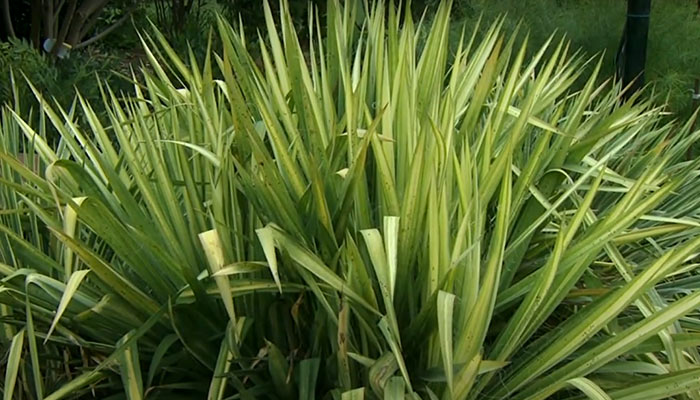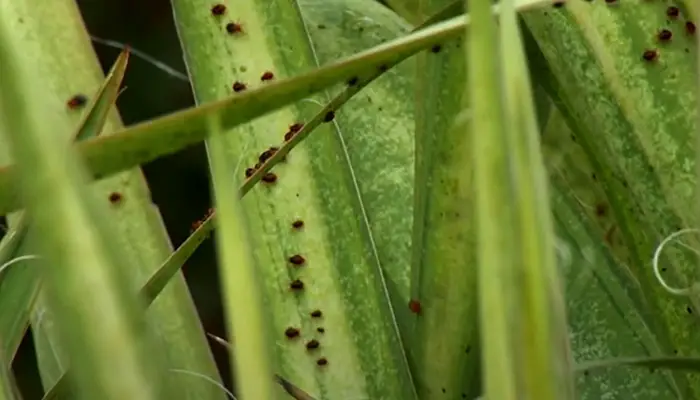If you see black spots on yucca leaves in your garden, you can be sure that it is because of overwatering, poor drainage, overhead watering, high atmospheric humidity, low temperature, infected soil, insects and diseases.
You can solve the problems easily by maintaining the microclimate of the plant surrounding. That’s why I have described here the important elements that they need to survive better. As well as the ways which are important for the plant survival against insects that create these spots.
You can get a quick idea from the table that I mentioned here-
| Problems | Solutions |
| Overwatering and poor drainage | Water the plant when it needs and keeps the drainage system undisturbed. |
| Overhead watering | Water at the root zone of the plant |
| High humidity | Don’t allow to increase in the humidity over 40% |
| Low temperature | Maintain the temperature between 65-85°F around the plant |
| Infected soil | Use sandy loam soil that is highly nutritious and healthy |
| Insects | Apply to rub alcohol to the spots and use pesticides |
| Diseases | Use fungicides or bactericides |
Top 7 Reasons That Cause Black Spots On Yucca Leaves

1. Overwatering and Poor Drainage
One of the main reasons that may cause black spots on yucca leaves is over-watering. Yucca plants do not love much watering as excessive watering makes them prone to root diseases. Root rot is one of them.
High watering percentage and lack of drainage make the roots vulnerable to disease-causing pathogens. As a result, the root system cannot serve the plant with enough materials needed for its growth and getting a healthy stature.
Thus, insects can attack the plant easily and black spots are formed on the leaves. The drainage problem adds much to this problem of the plant.
Control Measures
Yucca plants don’t need excessive watering. So water your plant only when around 75% of the soil gets dry. As they love dry weather, make sure that the drainage system of the pot or the soil outside is undisturbed. Water should not remain stagnant in the root zone.
2. Overhead Watering
This problem is a little different from many other plants in the yucca plant. Overhead watering is watering the plant on the top of the leaves or stems using a hose or pipe. Though many plants love such a sprinkle in hot weather, it is disastrous for a yucca plant.
If you overhead this plant, it starts to gather excessive moisture at that place which becomes susceptible to insects and pathogens. Commonly, insects love soft and tender leaves and so this situation becomes more favorable for the insects.
Control Measures
Controlling the overhead watering problem is almost the same as the overwatering problem. You can check that portion again for this solution. Additionally, you should water your plant in the root zone rather than sprinkling water overhead or on top of the leaves.
3. High Atmospheric Humidity
Then, high atmospheric humidity is harmful to the yucca plant. High humidity is auspicious for insect and disease growth. As a yucca plant is a xerophytic plant or loves to stay in dry weather, they become weak in high humidity.
At a parallel sequence, the insects and pathogens can also grow at a high range in this moisture level. Hence, they affect the plant and drastically reduce the plant’s resistance ability. Thus, the plant becomes pale and wilted in high atmospheric humidity.
Control Measures
Always try to keep your plant in a low-humid area. Yucca plants grow better in 40% humidity. They can even tolerate and grow in 10% humidity. To maintain the level of the surrounding around this percentage.
When the atmospheric humidity is high, keep them inside or cover the plant with necessary elements so that humid weather cannot make any harm to them.
4. Low Temperature
Apart from those, low temperature also causes problems for the plant. Though they are hardy to extreme cold, freezing conditions may hit their mechanisms and make them vulnerable to the plant.
When the atmospheric temperature is excessively low, the temperature effect becomes higher on yucca leaves. The water freezes in the root zone of the plant and so the plant cannot uptake water to make it available for photosynthesis.
Again, since the water freezes also in the leaves, the photosynthesis process is hampered and the plant cannot complete proper food production processes. This also makes the plant prone to diseases.
Control Measures
Apply enough water to the plant while the low temperature is continuing. You can use a little bit of Epsom salt to recover the damage to the plant. But you should be careful in this case because excessive salt creates a physiological drought for the plant.
Try to maintain the temperature between 65-85°F if possible for the indoor yucca plants. If the plant is kept outdoors, cover the plant with the necessary elements to save it from frost. Though some varieties of yucca may live at -34°F too, many other varieties become stressed at that time.
5. Infected Soil
If the soil properties are infected and not appropriate for the plant, black spots may be seen on the yucca leaves. The soil can be infected in various ways. If bacterial, viral, fungi or nematode inoculums get mixed in the pot, the plant become affected through the soil.
If the soil moisture is high, the pathogens can continue their reproduction system at a higher percentage and as a result, they infect the plant at a higher rate. Again, the soil also cannot supply enough nutrient materials for the plant.
Control Measures
The soil should be sandy loam and well-drained containing high-nutrient materials. Again, the moisture level of the soil should be reduced. If the soil is too infected, you can report the plant.
Repotting is the procedure of uprooting and planting in a new pot. The new pot should contain nutritious soil that is necessary for the proper establishment of the plant.
6. Insects

Insects are the main culprit that makes the black spots on the plant such as-
- Scale
- Aphids
- Yucca bugs
These insects suck the cell sap from the veins of the plant. As a result, the food produced in the leaf cannot reach the other parts of the plant. On the other hand, the insects create excreta and they fall on the upper surface of the yucca leaves. These excreta are the black spots which prevent the photosynthesis process of the plant.
Control Measures
These insects can be controlled by using insecticides. You can use chemical insecticides or organic solutions. But using insecticides needs a lot of precautions. Hence, while using those, you should maintain them all. You can use them if you find them near to you.
If you want to use organic insecticides, I can suggest some which are-
- Neem oil
Dilute 2 tablespoons of concentrated neem oil in 1 gallon of water and mix it well. Then spray the plant.
- Dish soap solution
Mix 1 gallon of water, ½ liter of rubbing alcohol and 4 tablespoons of liquid dish soap properly and spray to the plant.
- Baking soda
Take 4 tablespoons of baking soda and mix it in 1 gallon of water. Then spray the plant.
Else, you can also wipe the leaves where black spots are available with rubbing alcohol to save the leaves. Thus, you can protect your plants from insects.
7. Diseases
When insects affect the plant, the pathogens also get their ways to enter the plant and cause diseases. It may be a bacterial, viral or fungal disease such as-
- Cercospora leaf spot
- Bacterial leaf spot
- Bacterial leaf blight
Control Measures
To control the diseases of the plant, you may rely on industrial fungicides or bactericides if it is near your hand. Otherwise, you can take the help of organic pesticides like
Caring Guides For Yucca Plants
| Climate | Warm and dry weather |
| Soil | Sandy loam and well-drained soil |
| Temperature | 65-85°F |
| Humidity | Around 40% |
| Sunlight | Full sun to partial sun |
| Watering | Water your plant when 75-90% soil is dry |
| Fertilizer | Liquid fertilizer application in spring and summer once a month |
| Repotting | Every two to three years in the summer |
FAQs
Can the growth rate of the yucca plant become slow due to the black spots?
Yes, it can. Though yucca is a slow-growing plant, the growth rate becomes slower if the black spots appear as the plant becomes affected by insects and diseases.
Is the yucca plant winter hardy?
Yeah! It is more tolerant than many other houseplants. Even it can survive through -30 to -34°F. But some of the yucca varieties are not too cold-resistant. They may face problems in such frosty weather.
Can I grow yucca plants indoors?
Obviously, you can. Yucca is both an indoor and outdoor plant. You can grow this both in an indoor and outdoor environment by supplying enough materials.
Is the yucca plant toxic to pets and humans?
A yucca plant is mildly toxic to pets and humans. Those who have allergic or other skin problems may face itching, rashes or other types of skin irritations.
Final Words
Here is the last phase of my discussion as I have to end now. You can maintain a yucca plant easily by supplying the important materials for the plant. It doesn’t require much caring or observance. But if you can provide them with what they need, the plant will be healthy.
A healthy yucca plant is more resistant to insects and diseases. Thus, you can prevent the infestation before attacking. Despite all these, if your plant gets affected, you can apply the methods that I included here. I hope that you can save your plant by following these.
- Propagating Plumeria Trees from Cuttings: Easy Steps - July 13, 2024
- How to Plant Plumeria Clippings? Easy Growth Guide - July 12, 2024
- How to Make a Plumeria Bloom? Secret Tips Revealed! - July 12, 2024

